
Applied Data Science Coding with Python: LDA Algorithm
The Linear Discriminant Analysis (LDA) algorithm is a method for classification in machine learning. It is used to find a linear combination of features that separates different classes in the dataset with the greatest possible margin.
The LDA algorithm starts by finding the mean vectors of the different classes in the dataset, which represent the center of the classes. Then, it finds a linear combination of features that maximizes the ratio of the between-class variance to the within-class variance. This linear combination of features is called the discriminant function and is used to project the data points onto a lower-dimensional space where the classes are well separated.
In order to use the LDA algorithm in Python, you need to have a dataset that includes both the input data and the labels or outcomes. You also need to decide on the number of dimensions for the lower-dimensional space, which is called the number of discriminants.
There are several libraries available in Python to implement the LDA algorithm, such as scikit-learn, NumPy, and Pandas. These libraries provide pre-built functions and methods to build, train and evaluate a LDA model.
It is important to note that LDA algorithm assumes that the data is normally distributed and the classes have equal covariance matrix. Therefore, it’s important to check these assumptions before applying LDA algorithm. Also, if the number of observations per class is less than the number of features, LDA algorithm won’t work.
In summary, the Linear Discriminant Analysis (LDA) algorithm is a method for classification in machine learning. It finds a linear combination of features that separates different classes in the dataset with the greatest possible margin. There are several libraries available in Python to implement the LDA algorithm, and it’s important to check the assumptions of the algorithm before applying it, and also to make sure the number of observations per class is greater than the number of features.
In this Applied Machine Learning & Data Science Recipe (Jupyter Notebook), the reader will find the practical use of applied machine learning and data science in Python programming: How to apply LDA Algorithm.